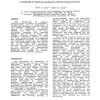Free Online Productivity Tools
i2Speak
i2Symbol
i2OCR
iTex2Img
iWeb2Print
iWeb2Shot
i2Type
iPdf2Split
iPdf2Merge
i2Bopomofo
i2Arabic
i2Style
i2Image
i2PDF
iLatex2Rtf
Sci2ools
SP
1987
IEEE
1987
IEEE
A Comparison of Commercial and Military Computer Security Policies
Most discussions of computer security focus on control of disclosure. In Particular, the U.S. Department of Defense has developed a set of criteria for computer mechanisms to provide control of classified information. However, for that core of data processing concerned with business operation and control of assets, the primary security concern is data integrity. This paper presents a policy for data integrity based on commercial data processing practices, and compares the mechanisms needed for this policy with the mechanisms needed to enforce the lattice model for information security. We argue that a lattice model is not sufficient to characterize integrity policies, and that distinct mechanisms are needed to Control disclosure and to provide integrity.
Related Content
| Added | 28 Aug 2010 |
| Updated | 28 Aug 2010 |
| Type | Conference |
| Year | 1987 |
| Where | SP |
| Authors | D. D. Clark, D. R. Wilson |
Comments (0)

